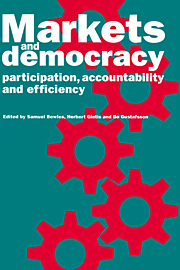Book contents
- Frontmatter
- Contents
- List of figures
- List of tables
- Preface
- 1 Post-Walrasian political economy
- Part I Agency, incentives, and democratic accountability
- Part II Institutions and institutional change
- Part III Conditions for the success of the democratic firm
- Part IV Productivity, distribution, and power
- Part V Ownership, participation and capital markets
- 14 The motivational role of an external agent in the informationally-participatory firm
- 15 Unstable ownership
- 16 The simple analytics of a membership market in a labor-managed economy
- Part VI Political democracy and economic democracy
- Bibliography
- Author index
- Subject index
16 - The simple analytics of a membership market in a labor-managed economy
Published online by Cambridge University Press: 05 March 2012
- Frontmatter
- Contents
- List of figures
- List of tables
- Preface
- 1 Post-Walrasian political economy
- Part I Agency, incentives, and democratic accountability
- Part II Institutions and institutional change
- Part III Conditions for the success of the democratic firm
- Part IV Productivity, distribution, and power
- Part V Ownership, participation and capital markets
- 14 The motivational role of an external agent in the informationally-participatory firm
- 15 Unstable ownership
- 16 The simple analytics of a membership market in a labor-managed economy
- Part VI Political democracy and economic democracy
- Bibliography
- Author index
- Subject index
Summary
Introduction
The defining feature of a Labor-Managed Firm (LMF) is that the ultimate decision-making rights are assigned to the workers. From this we can expect that the decisions of the LMF conform to the interests of the (majority of) worker-members. But which worker-members do we mean? In an intertemporal context we must distinguish between the ex ante members of period t and the ex post members of period t. The ex post membership consists of the ex ante members who remain with the LMF and those additional workers who join the LMF during the period. They will be the ex ante members of period t + 1. It seems obvious that the ex ante members make the decisions in any given period because those who are not yet members of the LMF can hardly be given a direct say in firm decisions. To be more precise: assume that decisions are made at the beginning of the period. Only those who are a member of the LMF at that time, i.e., the ex ante members, can participate in these decisions while those who join the LMF later are excluded.
Beginning with Ward (1958), Domar (1966) and Vanek (1965) the larger part of the economic theory of the LMF assumes that LMFs maximize the (present value of) per capita income of ex post members. A recent example is Drèze (1989). The LMF is thus assumed to act in the interests of its ex post members in any given period.
- Type
- Chapter
- Information
- Markets and DemocracyParticipation, Accountability and Efficiency, pp. 260 - 276Publisher: Cambridge University PressPrint publication year: 1993
- 7
- Cited by



